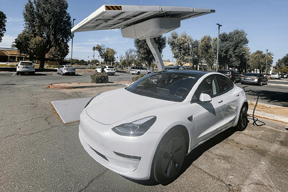
Dear EarthTalk: Is the so-called “greening” of Antarctica as its ice melts actually helping to prevent climate change given that plant life absorbs and stores carbon? ~ W.P. Smith, via email

As Antarctica warms due to climate change, an unexpected phenomenon is occurring: the “greening” of the continent. As ice melts, certain areas once covered in snow and ice are becoming hospitable to algae and other plant life. A key question arises: Does the increased carbon capture from this greening offset or help prevent climate change?
The “greening” of Antarctica primarily refers to the growth of green snow algae, which thrive in the increasingly warmer temperatures of the Antarctic Peninsula. As temperatures rise slightly above freezing, especially in coastal regions, these algae blooms are expanding significantly. These blooms are acting as carbon “sinks,” absorbing carbon dioxide (CO2) through photosynthesis, which reduces greenhouse gases. According to a study by the University of Cambridge, green snow algae in Antarctica capture approximately 479 tonnes (metric tons) of CO2 annually, and their growth is expected to increase as the snow melts and more land becomes suitable for these blooms.
While the role of algae as a carbon sink is positive, there are several limitations to its impact on mitigating climate change. First, the scale of the carbon sequestration is relatively small when compared to global CO2 emissions. The estimated 479 tons of CO2 captured by Antarctic algae is just a fraction of the billions of tons emitted annually worldwide, rendering its contribution minimal in the grand scheme. As a result, while algae may contribute to reducing atmospheric CO2, it does not provide a large enough offset to make a significant dent in global warming.
Moreover, the overall ecological and climate impacts of Antarctica’s greening are most concerning. The melting of Antarctic ice is leading to rising sea levels, which far outweigh the benefits of carbon sequestration by its algae. And this global sea level rise threatens coastal communities and ecosystems around the world. Additionally, the introduction of plant life into Antarctica’s fragile ecosystem may create new environmental challenges, disrupting existing species and possibly causing further ecological shifts that could have unforeseen consequences.
While Antarctic algae blooms represent an interesting phenomenon, to combat climate change effectively we need to focus on reducing our carbon footprint through renewable energy, supporting reforestation projects, advocating for strong climate policies, and reducing waste.
MORE INFORMATION: https://www.sciencedaily.com/releases/2024/10/241007115554.htm; https://www.cam.ac.uk/stories/antarctica-turning-green.
Dear EarthTalk: What’s new in the greening of air travel and the aviation? ~ D.M. Norwalk, CT

Air travel is pretty environmentally unfriendly. In 2018, civil aviation emissions constituted 2.5 percent of global human carbon dioxide (CO2) emissions. Released at high altitudes, these emissions impact the climate two to four times more than ground-level emissions. Consequently, civil aviation accounts for about 3.5 percent of human-induced global warming. Considering that air travel is mostly a leisure activity, not a necessity, this makes it one of the most environmentally harmful leisure activities. Despite calls to reduce air travel, flights are increasing upwards of three percent per year.
Instead of reducing flights, many companies and aviation organizations are promising net-zero aviation in the coming decades. The International Air Transport Association (IATA) aims for net-zero CO2 emissions by 2050 through eliminating emissions at the source. Central to this plan is a switch from kerosene to Sustainable Aviation Fuel (SAF), which is expected to reduce 65 percent of emissions.
SAF is made from organic waste or synthesized by combining hydrogen with captured CO2. Tests on over 200,000 flights indicate that SAF can reduce lifecycle emissions by up to 80 percent. The first flight using 100 percent SAF was Virgin Atlantic’s flight between London and New York in November 2023. According to Virgin it “demonstrate[d] the capability of SAF as a safe drop-in replacement for fossil-derived jet fuel, compatible with today’s engines, airframes and fuel infrastructure.”
Electric planes are another promising development. Some 200 companies are working on electric aircraft, which offer a 100 percent emission reduction and no climate impact during flights. However, current battery technology limits electric planes to a range of 531 to 621 miles. Large and long-haul electric passenger jets are expected to become viable only around 2040. Hydrogen-powered planes are also emerging. Instead of carbon emissions, these planes emit water vapor during flights. Companies like Airbus and Rolls Royce are developing hydrogen-fueled aircraft, ready for use in 2035. Hydrogen requires significant space, necessitating changes to aircraft design and ground infrastructure.
Green aviation is in its early stages, with no single solution available. For now, people can reduce their travel emissions by opting for cars, buses or trains. Choosing direct flights and fully booked planes also helps. Platforms like Skyscanner offer “greener” travel options by analyzing flight and environmental data. According to the International Council on Clean Transportation, the emissions difference between the most and least efficient airlines can be up to 26 percent.
MORE INFORMATION: https://www.atmosfair.de/en/offset/flight/; https://www.iata.org/contentassets/8d19e716636a47c184e7221c77563c93/executive-summary—net-zero-roadmaps.pdf; https://www.skyscanner.net/.
Dear EarthTalk: Is transitioning to more electric vehicles (EVs) good or bad for the economy overall? ~ Richard T., Boise, ID

According to the S&P Global Motility Forecast, EV sales have surged so substantially over the past two decades that about 50 percent of the vehicles on the road by 2040 are projected to be electric. Individuals who can afford the initial cost of an EV substantially reduce their carbon footprint while enjoying an average of $2,200 annually in fuel and maintenance savings. On a national level, however, experts have debated whether or not the increased electric utility revenue, job creation, and decreased oil dependence associated with EVs outweigh the costs of charging station installation and electrical grid upgrades.
Only 50 percent of the electrical capacity of the U.S grid is used, so as to accommodate large swings during peak demand. Ninety percent of current EV charging occurs at homes and places of business during off peak hours, thus, the amount used does not yet meet capacity. Pacific Gas and Electric (PG&E) and Southern California Edison (SCE) have found that EVs in their service areas contributed $806 million more in revenue than in associated costs, which drove rates down for all customers. If utility revenue remains higher than utility cost, EVs will lower the rate paid by all ratepayers. Conversely, if utilization approaches capacity, costly grid upgrades amounting to $3 billion across the U.S will be required.
The McKinsey Center for Future Mobility estimates that as the number of EVs increases, hardware, planning and installation costs of an expected 1.2 million public and 28 million private chargers will reach more than $35 billion. Though costly, charger installations create jobs, possibly lowering unemployment. Furthermore, a study by MIT found that charging stations boosted annual spending at nearby businesses.
The largest economic benefit of transitioning to EVs is a decrease in oil reliance. The U.S relies upon oil for 85 percent of transportation needs, and depends upon foreign providers to meet this demand. Oil price fluctuation is implicated in the majority of recent recessions, including in 2022, and is directly linked to consumer sentiment. Increased reliance on a domestic and diversified electrical grid will separate the U.S. from more economically volatile nations, positively impacting the U.S. economy.
Installing public chargers and upgrading the electrical grid will undoubtedly pose a large cost to the U.S. Still, job creation, utility company revenue and less oil dependence are projected to make it all worth it. In the long run, transitioning to EVs is projected to positively impact the economy. However, these estimates are based on a model whereby the utility cost of EVs is less than the increased revenue to electric providers. Time will tell whether this model holds true.
MORE INFORMATION: usceconreview.com/2022/11/14/the-economic-consequences-of-electric-vehicles/; sciencedaily.com/releases/2024/09/240904141512.htm.
EarthTalk® is produced by Roddy Scheer & Doug Moss for the 501(c)3 nonprofit EarthTalk. See more at https://emagazine.com. To donate, visit https://earthtalk.org. Send questions to: question@earthtalk.org.
